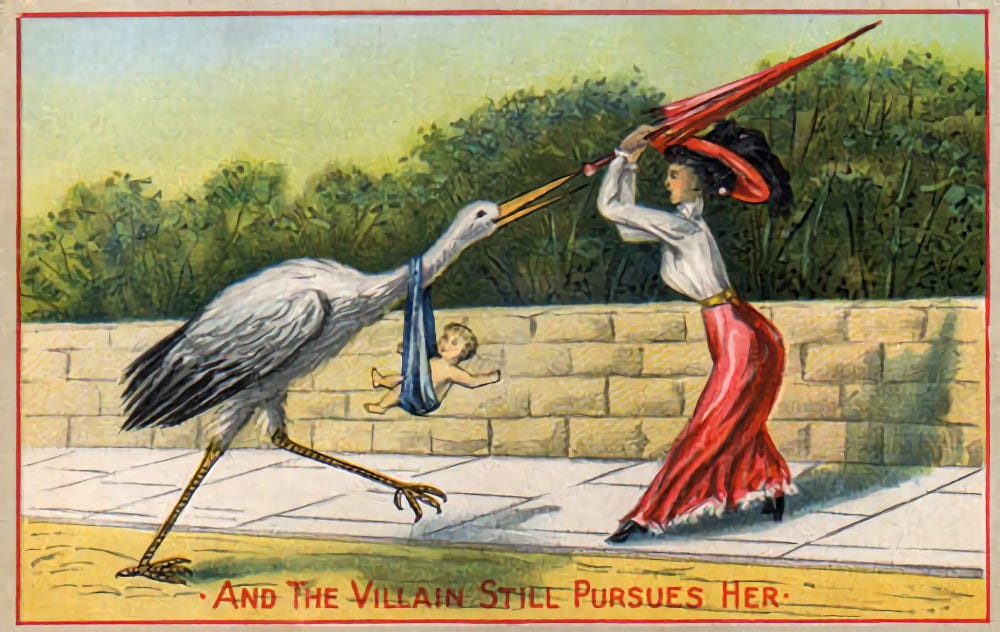Maybe Baby
How Contraception Transformed Victorian Society From Social Revolution to Women's Empowerment
Recently, while leafing through my well-worn copy of Geoffrey Barraclough's “An Introduction to Contemporary History”, I stumbled upon a passage that caught my eye. This book, which had accompanied me through my first university exams, held between its pages a precious insight into our social history
From about 1890 (…) there was a steady decline in the birth rate in industrialized Europe, the consequence not only of the spread of contraception but also of a higher standard of living and in some degree, perhaps, of the long economic depression.
What might seem like an obvious correlation today (the link between contraceptive availability and birth rates) was, in the late 19th century, still a reality in the making, a silent but revolutionary transformation of Victorian society.
The issue of demographic decline, which still ignites debates and concerns today, had already begun to emerge as a social phenomenon worthy of attention. Intrigued by this historical continuity, I began gathering information to better understand the roots of this epochal change.
Contraception and Social Change
The adoption of contraceptive methods in the late Victorian era signaled a profound transformation in human agency. People were beginning to assert control not only over moral questions but over their bodies and natural functions themselves.
This was an age when industrialization was reshaping not only city skylines but the very fabric of family life. Urban living and its economic pressures had fundamentally altered the value of large families. While numerous children had once been a blessing in rural communities, where every pair of hands could work the land, the realities of city life - with its rising costs and cramped quarters - pushed many families to limit their size.
Added to these dynamics was the emergence of neo-Malthusianism, armed with compelling arguments about population control as a path to prosperity. Their ideas found fertile ground particularly among the educated urban classes, who increasingly saw family planning as a practical response to the social and economic pressures of their time.
France during the Belle Époque offers a fascinating case study. The country experienced one of the most dramatic demographic declines in Europe from the mid-19th century onward, a phenomenon that generated intense political debate and social anxiety.
This preoccupation with falling birth rates even found its way into literature - most notably in Émile Zola's novel “Fécondité” (1899), which described the collective unease about a future with fewer French children.
Contraceptive Methods in the Late 19th Century
In the closing decades of the Victorian era, couples seeking to control their fertility had limited options. Traditional practices like coitus interruptus and periodic abstinence remained common, yet technological advances were about to revolutionize reproductive control.
The crucial moment came with Charles Goodyear's discovery of vulcanized rubber in 1839, patented in 1844. This innovation allowed natural rubber to be treated with sulfur and heat, creating a material both durable and flexible - qualities that would prove transformative for contraception.
Before vulcanization, condoms were crafted from impractical materials: animal intestines or linen, making them expensive and unreliable. The new rubber condoms, though initially marketed for disease prevention rather than birth control, offered unprecedented accessibility and reusability.
Vulcanized rubber also enabled the production of diaphragms, which emerged in the latter part of the century. These devices, alongside traditional methods like spermicide-soaked sponges, gave women autonomous control over their fertility for the first time.
The availability of female-controlled contraceptive methods became inextricably linked with the rising feminist movement, representing a tangible step toward women's emancipation.
anonymous, Spermicidal Pessaries, ‘Prorace’ brand, London, England, 192 Wellcome L0065399, CC BY 4.0
Birth Control and the Feminist Movement
The 1877 Knowlton Trial in Britain illuminated the growing tensions around reproductive rights. When activists Charles Bradlaugh and Annie Besant stood trial for distributing a pamphlet on contraceptive methods written by American doctor Charles Knowlton, they transformed a courtroom into a platform for neo-Malthusian ideas. Their defense articulated a radical notion: working-class families deserved access to contraceptive information to align their family size with their economic means.
Neo-Malthusian philosophy, with its warning that unchecked population growth bred poverty and suffering, found natural allies in the emerging feminist movement. For feminist thinkers, birth control represented a powerful tool for women's agency over their bodies and family responsibilities.
Yet in the United States, the 1873 Comstock Act cast a long shadow. By criminalizing the distribution of contraceptive information and devices, along with any content addressing sexuality or family planning, it revealed deep-seated social resistance. Religious and moral opposition feared contraception would unravel traditional family structures and encourage sexual promiscuity.
The concept of 'voluntary motherhood' emerged as one of the era's most radical expressions of women's rights. While carefully avoiding explicit promotion of contraception, it boldly recognized female sexuality and asserted women's right to choose when to bear children. In a society where wives were expected to submit to their husbands' desires, advocates of voluntary motherhood proposed periodic abstinence, effectively claiming women's right to refuse sexual relations.
Feminist Dora Forster seized upon demographic anxieties in 1905 to advance women's autonomy. She declared:
I hope the scarcity of children will go on till maternity is honored at least as much as the trials and hardships of soldiers campaigning in wartime. It will then be worth while to supply the nation with a sufficiency of children. [...] It is certain that women is mistress of the situation now that she can choose whether or not to exercise the maternal function; and that every civilized nation, having lost the power to enslave woman as mother, will be compelled to recognize her voluntary exercise of that function as by far the most important service of any class of citizens.
Thanks for reading Flâneur du Passé! Subscribe for free to receive new posts and support my work.
Interconnected causes
The Victorian era witnessed a fundamental shift in how society approached reproduction. Social transformation through industrialization and urbanization reshaped family attitudes, while technological innovations like vulcanized rubber created new possibilities for reproductive control.
Ideological movements amplified these changes. Feminism and neo-Malthusianism advocated for birth control from different perspectives: one seeking women's emancipation, the other pursuing population management to improve working-class conditions. Together, they created a powerful argument for reproductive choice.
This transformation in Victorian society went beyond questions of family size. It represented a profound shift in how individuals viewed their relationship with their bodies and their future.
The spread of contraception became emblematic of a larger social revolution: the right to self-determination.
By claiming control over reproduction, Victorian women and men laid the groundwork for personal freedoms that would shape generations to come.
Sources
G. Barraclough, An Introduction To Contemporary History (1964)
L. Gordon, The Moral Property Of Women: A History Of Birth Control Politics In America (chapter 4 on “Voluntary Motherhood”).
D. Forster, Sex Radicalism as Seen by an Emancipated Woman of the New Time (1905)



